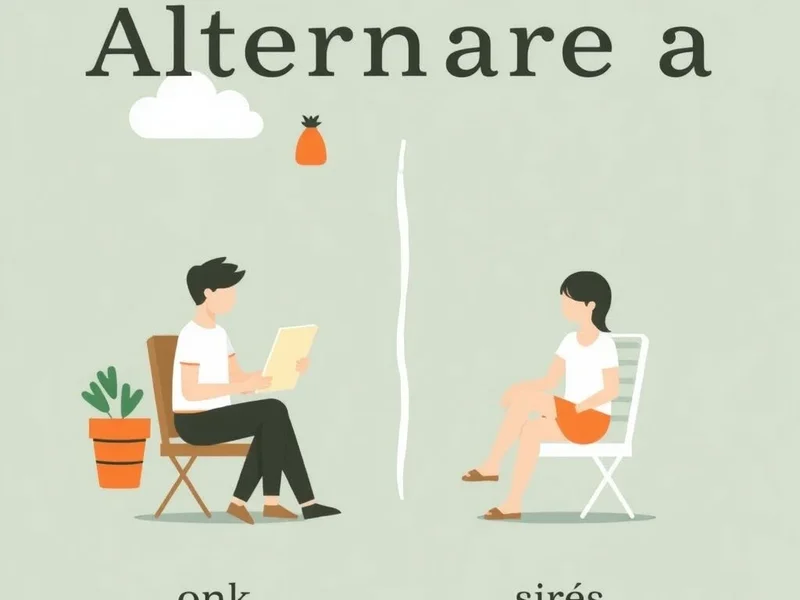How to Use "Alternare a": Meaning and Practical Examples
Learning Italian also means understanding the nuances of verbs and prepositions. Today we’re talking about a very useful phrasal verb in natural spoken Italian: "alternare a." It seems simple, but using the correct preposition is fundamental. Have you ever wondered whether to use "alternare a" or "alternare con"? In this article, we’ll explore the meaning, grammatical structure, and practical examples of "alternare a" to help you communicate in Italian more confidently and avoid common mistakes. By the end, you’ll be able to use this expression without hesitation.

Table of Contents
- What does “Alternare a” mean?
- The Grammatical Structure: How is it Used?
- Sentences and Examples with “Alternare a”
- Crucial Differences: Common Mistakes to Avoid
- Similar or Related Expressions
- Conclusion
What does “Alternare a” mean?
This phrasal verb is fundamental in practical Italian vocabulary to express the idea of variation or succession.
- Literal Meaning: To put one thing after another in succession, exchanging them periodically or regularly.
- Example: "Il pittore alternava colori chiari a colori scuri sulla tela."
- Figurative Meaning: To make one thing follow another, varying over time between two or more elements, activities, or moods.
- Example: "Alternava momenti di studio intenso a momenti di relax assoluto."
More: How to Use Alludere a with Practical Examples and Structure
The Grammatical Structure: How is it Used?
The verb "alternare" is a transitive verb that requires the preposition "a" to introduce the second element, that is, what the first alternates with. This is a key point of B1-B2 Italian grammar for proper usage.
- Formula:
[Subject] + alternare + [Thing 1] + a + [Thing 2]
The preposition "a" is crucial because it indicates the indirect or relational object, specifying to which element the exchange or succession happens. You don’t say "alternare il lavoro con il riposo", but rather "alternare il lavoro al riposo". This concept helps you understand how to use "alternare a" in natural speech. For a more complete overview of the verb "alternare" and its nuances, you can consult authoritative dictionaries such as the Dizionario Internazionale di Internazionale.it.
More: How to Use Aiutare a with Italian Examples for Natural Speaking
Sentences and Examples with “Alternare a”
Here are some practical examples with "alternare a" in real contexts, to cement your understanding and help you use useful Italian phrasal verbs.
📍 Daily Life / Well-being
Person A: "How do you stay so energetic during the week?"
Person B: "Cerco di alternare a periodi di lavoro intenso delle pause rigeneranti. Fa bene alla mente!"
📍 Sports / Training
Person A: "What’s your secret for effective running?"
Person B: "Mi piace alternare alla corsa veloce dei tratti più lenti. Aiuta a migliorare la resistenza."
📍 Cooking / Recipes
Person A: "This cake is delicious! How did you make the filling?"
Person B: "Ho deciso di alternare a strati di crema pasticcera della frutta fresca, come fragole e kiwi."
📍 Work / Projects
Person A: "How do you manage different project tasks?"
Person B: "Di solito alterno a riunioni lunghe delle sessioni di lavoro individuale. Così rimango produttivo."
More: Aggrapparsi a Meaning and Practical Examples
Crucial Differences: Common Mistakes to Avoid
The main confusion often arises between using "alternare a" and "alternare con." It’s a common mistake for Italian learners.
- Alternare a: This is the correct construction to indicate that one element follows another in a sequence, or that there is variation between two or more things. The preposition "a" introduces the element that the first one is exchanged with.
- Example: "Durante la lezione, la professoressa ha deciso di alternare alla spiegazione teorica degli esercizi pratici." (Meaning: first theory, then exercises, and so on).
- Alternare con: The use of "con" in this context is almost always a mistake. "Alternare con" is not grammatically correct for expressing succession or variation between elements. While "con" can indicate "together with", in this specific case it doesn’t express the sense of "having one thing follow another".
- Example (incorrect): "Molti studenti alternano con lo studio il tempo libero."
- Example (correct, using "a"): "Molti studenti alternano allo studio il tempo libero."
Similar or Related Expressions
To enrich your practical Italian vocabulary, here are some expressions that share a similar meaning or are related to "alternare a".
| Similar Expression | Brief Meaning | Example |
|---|---|---|
| Variare | To change, to diversify | "Mi piace variare la mia routine quotidiana." |
| Sostituire a | To put in place of | "Ho sostituito lo zucchero al miele nella ricetta." |
| Alternarsi | To take turns | "Loro si alternano alla guida ogni due ore." |
Conclusion
We hope this detailed guide has clarified for you how to use "alternare a". This expression means to vary between two or more elements in succession, and it always requires the use of the preposition "a." Understanding the meaning of "alternare a" will help you communicate in Italian more fluently and naturally.
Now that you know the correct use of "alternare a," try writing a sentence in the comments using this expression. How do you alternate your activities during the day?
Sponsor Looking for ways to diversify your investment portfolio? Freedom24 ETF - English offers a wide selection of ETFs to help you invest in key sectors with just one click. Explore over 3,600 global ETFs and access expert market research to make informed decisions. Open an account with Freedom24 today and start trading with confidence!